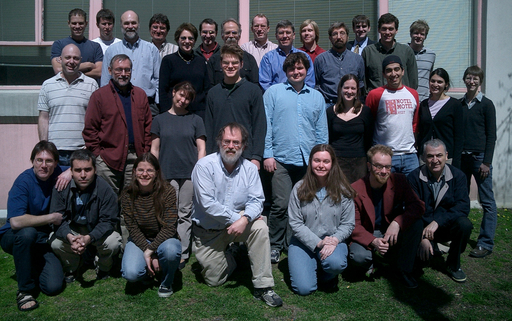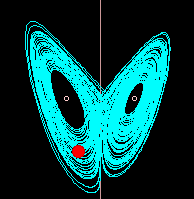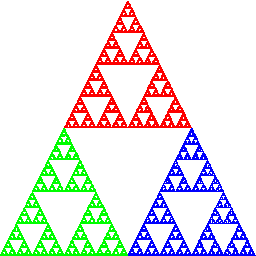The Dynamical Systems Group at Boston
University
The
dynamics group at Boston University was founded in the late
1970s. At its core, the dynamics group consists of seven faculty,
approximately 15 PhD students, and a number of postdocs. More
broadly, participants in dynamics group activities also include many
of the postdocs and students of the Center for BioDynamics -- which has as its primary
mission the advancement of applications of dynamical systems in the
biological and engineering sciences.

This photograph was taken Monday April 11, 2005 outside the
Mathematics Department of Boston University.
Front row (from left): Kalin Kostadinov, Sebastian Marotta,
Margaret Beck, Dick Hall, Elizabeth Russell, Dan Look, and Mamikon
Ginovyan.
Second row (from left): Horacio Rotstein, Bob Devaney, Marina
Bevzushenko, Eric Wahl, Oleg Mikitchenko, Elizabeth Zollinger, David
Uminsky, Cecilia Behn, and Chelsea Smock.
Third row (from left): Ehud Sivan, Paul Blanchard, Nancy Kopell, David
Fried, Gene Wayne, Steve Epstein, and Jozsi Jalics.
Back row (from left): Matt Holzer, Gabriel Soto, Nikola Popovic, Tasso
Kaper, Baldur Hedinsson, Russell Jackson, and Peter Barendse.
The group's research and training missions span topics in pure and
applied dynamical systems, ranging from complex dynamics, dynamical
zeta functions, and Hamiltonian dynamics to rhythms in the nervous system,
invariant manifolds for PDEs, and multiscale systems. Faculty members
and their primary dynamics interests are:
| Paul Blanchard: |
|
 |
| |
complex analytical dynamical systems, dynamics of
Newton's method, rational maps whose Julia sets are Sierpinski curves, differential equations education. |
| Bob Devaney: |
| |
complex analytic dynamical systems, iterations of rational
and entire functions, chaotic dynamics, structures of Julia sets especially
those that are Sierpinski curves, problems at the interface
of topology and dynamics, singular perturbations of analytic maps. |
| David Fried: |
| |
dynamical zeta functions, periodic orbits, hyperbolic flows,
Reidemeister torsion, and symbolic dynamics for geodesic flows on
noncompact hyperbolic manifolds. |
The ODE project |
| Dick Hall: |
| |
celestial mechanics, coorbital moons (Janus and Epimethius of Saturn),
shepherding moons (e.g., in the F-ring of Saturn), triple collision problems,
Hamiltonian systems, geodesic flows, twist maps. |
| Tasso Kaper: |
| |
systems with multiple time and/or length scales, geometric
singular perturbation theory, stability and bifurcation of patterns in
activator-inhibitor systems, model reduction in chemistry, renormalization
groups methods in perturbation theory, dynamics of gas bubbles. |
| Nancy Kopell: |
| |
rhythms of electrical activity in the nervous system, their
origins, coherence, and functional implications, applications to olfaction,
auditory cortex, neocortex, schizophrenia, and the mechanisms of anesthetics,
invariant manifold theory for multiple scale systems, canards in localization
phenomena and in coupled oscillators, applications of geometric singular
perturbation theory to a variety of problems. |
| Gene Wayne: |
| |
conservative and dissipative PDEs, KAM theory for Hamiltonian PDEs,
invariant manifolds of solutions of the Navier-Stokes equations, validity
of the KdV and other approximations for interacting water waves, invariant
manifolds for dissipative PDEs. |
The group has had a dedicated postdoc position for the past 20 years
-- which has rotated among the subdisciplines -- as well as some NSF postdocs.
A partial listing includes: Amitabha Bose (N.J.I.T.),
Arek Goetz (San Francisco State U.), Russell Jackson (USNA),
Kresimir Josic (U. Houston), and Bruce Peckham (U. Minnesota, Duluth).
Also, former CBD postdocs are listed on the CBD website.
Postdoc Guillaume van Baalen recently completed his thesis with
Jean-Pierre Eckmann (Geneva) and works on invariant manifolds for
PDEs, especially for the Navier-Stokes equations, on phase turbulence
in the complex Ginzburg-Landau equation, and on the
Kuramoto-Sivashinsky equation. Postdoc Nikola Popovic recently
completed his thesis with Peter Szmolyan (Vienna) and works on
singularly perturbed systems, geometric desingularization, rigorous
asymptotics, stability of weak shocks, problems with logarithmic
switchback terms, a gene regulatory network problem, and on
micromagnetics.
Besides the research and guiding of postdocs, a central group
mission is the mentoring of
dynamics students. This is done both in individual
research groups as well as in jointly-sponsored groups, with many
students working with more than one advisor. Also, the students are
actively engaged with teaching each other, mainly through their weekly
student seminar, which they have been running for the past several
years. These activities -- along with social activities -- have
greatly helped to promote group cohesion.
The group sponsors a weekly
dynamics seminar on Mondays. This features
a mix of internal, regional, national, and international speakers, as
well as alumni. Of course, the real reason to host these seminars is
for the faculty to learn more about each other's topic areas. For example,
Bob Devaney still wonders why all reaction-diffusion equations involve
cubic nonlinearities.
Nonlinear dynamics also flourishes in other departments at BU.
Provost and physics professor David Campbell leads a research group
in physics and continues to serve as editor-in-chief of the AIP
journal Chaos. Physics professor Sid Redner was the Ulam Scholar
at the Center for Nonlinear Studies at Los Alamos National Laboratory
in 2004-5 and is active in the CBD. Biomedical Engineering professor
Jim Collins co-directs the CBD and has a large research group working
on various applications of dynamical systems and mathematics to
problems in gene regulatory networks, noise-based sensory prosthetics,
and human balance control. He has also carried out mathematical work on
stochastic resonance, symmetry in gaits, and attractor reconstruction
from short experimental time series.
Finally, several group members are active in educational efforts
involving dynamics and differential equations. For example, Bob, Dick,
and Paul direct the ODE project, which promotes the use of ideas from
the modern theory of dynamical systems in the traditional
sophomore-level course in differential equations. Their textbook
stresses qualitative, analytic, and numerical approaches and will soon
come out in its third edition.
 |
|
Related educational endeavors include the
Dynamical Systems and Technology
Project, led by Bob, which is designed to help secondary school
and college teachers of mathematics bring contemporary topics in
mathematics into the classroom, and to show them how to use technology
effectively in this process. The tip of the iceberg is visible at
http://math.bu.edu/DYSYS/ where a series of JAVA
applets are up and running that allow the user to explore chaos and
fractals. Also, Bob runs two Math Field Days every Fall for high
school students, and these often feature Dick and his box of symmetry
toys. |
| Dancing Triangles |
All in all, we strive to maintain a collegial group within a
collegial department. In lighter moments, we may think of ourselves as
being the analogs of some central dynamics phenomena: Bob and his
group clearly form a chaotic attractor, since a series of students
working on theses with other dynamics faculty have worked with him on
some aspect of complex dynamics. David recurrently discovers the
underlying geometric and algebraic structures in the dynamical systems
he studies. Dick is affectionately known as a mild-mannered, yet truly
celestial mechanician by his students. Gene can find a smooth manifold
for just about anything and always works in the right spaces, or maybe
it's better to say that he works on complicated equations in easy
spaces, which makes him the envy of the geometers who work on simple
equations in complicated spaces. Nancy has become the wizard of
oscillations, and her interests transversely intersect just about
everyone's in the group. Paul gently supplies the institutional memory
function, and Tasso is normally a hyperbolic guy who finds it useful to spend time near slow manifolds to get research done.